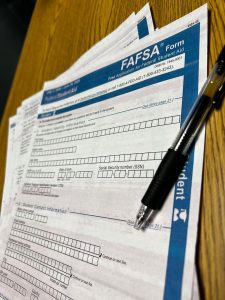It is easy to miss the small office on the third floor of the Social Science Building on the Boca campus. It is even easier to miss the tiny plate next to the door of Room 303, which reads, “Institutional Effectiveness & Analysis.”
“Not so many people know about us,” says Cynthia K. Condore, institutional research coordinator. “I think that’s a problem.”
Actually, FAU students and faculty do know what IEA offers. They just don’t know what IEA is.
The FAU Fact Book? Published by IEA. The Student Satisfaction Surveys? Conducted by IEA. The Student Perception of Teaching (SPOT) evaluations? Administered by the Office of Testing and Evaluation, but the reports are produced by the Office of Institutional Effectiveness & Analysis.
The IEA has three main functions, notes Condore: reporting and maintaining the official university data, conducting surveys to analyze the university’s effectiveness, and assessing the degree programs to meet the requirements of the accrediting agencies.
“Sometimes we receive phone calls or e-mails from people asking, ‘Can you do this (survey)?'” Condore says. “Of course we can! We are here for that. Then they would say, ‘Oh, I didn’t know that.'”
As the office’s name indicates, its main function is to collect data and analyze it to improve the programs and services at the university.
The most effective way to gather feedback from students and faculty is to conduct surveys.
Sharron (cq) Ronco, assistant provost in charge of IEA, considers the Student Satisfaction Survey “the best” because the results reflect how students feel about the education and services offered at the university.
The survey is conducted every two years on about 3,000 students, randomly selected. “We conduct the survey during the class period so that we have higher response,” explains Ronco, who came to FAU in 1997 from a similar position at the University of Texas at El Paso. The survey asks the students to rate the availability and quality of educational programs and on-campus services.
The most recent Student Satisfaction Survey was conducted in October. It shows that the satisfaction for the degree programs offered at FAU has increased from the previous survey, while more students are dissatisfied with the food services and the parking situation. Ronco says students are generally satisfied with their professors and class sizes but unhappy with class availability at the remote campuses.
“The results are sent to the appropriate departments for review,” Ronco says. “However, improvements may not be made right away because we need to look at the trends over time and the results must be studied thoughtfully.”
If students, faculty or staff need to use or are just curious about the results of the satisfaction survey or any other survey, they are all available on the IEA website, she says.
At the IEA website one can learn that the initial FAU enrollment for the Spring semester is 23,627, of which 61 percent are female, 17 percent are black, 14 percent are Hispanic, 306 are in the Honors College and 4,057 are on the Davie campus.
John Cahill, senior research analyst at IEA, says there is evidence that the university does make improvements based on IEA’s surveys and analyses.
In one of his projects, Cahill analyzes the relationship between the retention rate of freshmen and many variables, such as the type of instructor, credit hours and high school GPA. The Student Retention Committee, which includes members from IEA, the Office of Student Retention and the Office for Student Housing, reviews the results and comes up with action plans.
An example of the committee’s initiatives in recent years is the Freshman Learning Community. The community offers a one-credit course in the Fall semester to assist students with study skills. Members of the community may also take courses together and even live on the same floor in a dormitory to form a study group.
Cahill also assists the FAU Athletics Department with end-of-the-season surveys, and studies how to increase attendance at sporting events. Such analysis is crucial, especially for the football team, which moves to Division 1-A next season. The team must increase the average number of fans at home games from 4,387 to 15,000 in order to stay in the higher division.
Cahill’s other projects include conducting salary studies of the FAU faculty in comparison with other public and private universities. A new survey is being produced specifically for the Davie campus. “We administer the surveys for all the departments and campuses,” Cahill says.
The IEA often makes data available to outside agencies. The studies of student retention, for example, were presented at the Institutional Research Conference in November. And Condore is responsible for submitting the Common Data Set, which is a standard set of questionnaires used to evaluate U.S. colleges and universities, to U.S News and World Report so it can be used in publications such as America’s Best Colleges.
Since every survey and analysis the IEA conducts is meant to be public, Condore says, all the results are posted on its website. The Web site also provides filtering tools so the viewers can get the information they really need. The information could be useful to anyone who is doing research on the university.
Condore says that the feedback from students and faculty who have used the data has been “very positive.”
The results for the Web survey conducted in March 2001 support her claim. The majority of the viewers agreed that the IEA publications were attractive, accurate and easy to read and understand, and that they contained the information that was needed.
However, a mere 63 persons participated in the survey. One of the comments reads, “Let us know where your website is.”
Not many people know about IEA, Ronco admits, and that’s a problem. “I would love to get the word out there,” she says, “because we are here to help.”
And about that website – it’s at http://iea.fau.edu.











